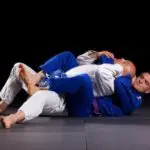The warm-up isn’t just to prepare your body for the movements unique to Jiu-Jitsu or grappling. It additionally serves as a way to practice moves that are commonly used to set up techniques, escapes, defenses, and position changes. They are the foundation for a lot of technical work used from white-belt to black-belt.
There are two main types of warm-ups: solo warm-ups and partner, drilling warm-ups. Solo warm-ups are moves that can be practiced and refined alone. They serve as a way to practice fundamental techniques in Jiu-Jitsu.
Drilling warm-ups use a partner and will give both people involved a chance to practice a technique with another person. Doing a warm-up with a partner will give a bit of resistance and a real sense of where the warm-ups fit into live rolling.
Practical Application
Jiu-Jitsu specific warm-ups are a great way to prepare and condition your body for movement patterns found in BJJ. The moves and techniques used during warm-up (at most BJJ gyms) are used in many different positions and techniques in Jiu-Jitsu.
For example, shrimping and bridging are one of the primary movements you’ll use for escaping many different positions. If you’re in side-control, knowing how to bridge will give you the space required to get your frames in safely while offsetting your opponent. Follow that bridge with a shrimp and you’ll create the space required to get your knee in to recover guard.
Setting up techniques or positional advantages will usually always have a warm-up technique utilized in it. From an X-Guard Sweep to rolling up to one knee to dope-mount is just one example. You can even Half-Granby your way from turtle to guard recovery in seconds!
The warm-up techniques can be hard to notice at first when the instructor is teaching a new technique. Once you do start noticing the warm-up moves you’ll realize you’re able to learn and retain them much quicker.
In live rolling try thinking about the warm-up techniques when attempting an escape or getting into a better position. Stuck in side-control? Just try a bridge and shrimp.
Are The Warm-Up Moves Difficult?
When starting in Jiu-Jitsu the warm-up moves can feel difficult. I remember my first class and I could not grasp how to shrimp, or bridge, or do a technical stand-up. All of the warm-up moves felt strange and awkward to me at first!
A lot of the warm-up moves will feel very foreign the first time you learn them. Some of those moves will come easier than others. The sideways roll took me many classes to finally grasp and perform properly. Meanwhile, I was able to do backward rolls on my first try.
Most things in life are difficult the first time you try it. The techniques used in warm-up are not difficult; however, if it’s your first time encountering them, then yes, they will be difficult! Over time, each one will get a bit easier. As each move gets easier you’ll notice your Jiu-Jitsu getting better.
What Is A Good BJJ Warm-Up?
A good Jiu-Jitsu warm-up will prepare the body to safely perform the moves used throughout the class while using techniques that are used everywhere. Using moves that are used in BJJ will improve performance and learning capacity.
Safely preparing the body to prevent injury in the number one priority in a warm-up. A warm-up shouldn’t take up the entire class, but it should be sufficient to get the body ready.
If the warm-up provides a method to practice and refined the techniques used throughout BJJ then learning new techniques incorporating it comes quicker. For instance, learning to Shrimp will assist in learning many escapes and technique setups.
Tip: Always make sure to practice both left and right sides of a technique. Shrimp left and right, roll with your head tucked to the left and the right!
BJJ Warm-Up Routine
A solid Jiu-Jitsu warm-up routine will help improve performance by working on the base movements and prevent injury. It does this by allowing you to perform the primary motions in BJJ without an opponent giving you resistance.
I’ve made a list of BJJ warm-up moves, below, that be done in class or practiced at home. These moves have been selected because most of them are the staple warm-up moves at most BJJ gyms. If your gym does not perform these I highly encourage you to practice them on your own.
Jiu-Jitsu Warm-Up Names
- Leg Circles
- Bridging
- Bridging to Turtle
- Roll-up to Combat Base
- Triangles
- Technical Stand-up to Breakfall
- Single/Double Leg Shrimp
- Reverse/Forward Shrimp
- Side Shrimp
- Forward Roll
- Backward Roll
- Sideways Shoulder Roll
- Granby Roll
- Half-Granby
- Sit Outs
- Rock-Overs
- Sprawls
Leg Circles
Leg circles from open guard are a great way to begin a warm-up because they help loosen up the hips and legs while being useful in live rolling. They’re useful in live rolling as they help defend against someone trying to grab the legs.
Bridging
Bridging is a great warm-up move because it gets the legs and core firing. The bridging motion is used everywhere in Jiu-Jitsu. It’s used to create space to allow you to better position your self or to bump someone off their balance if they’re mounted.
Bridging to Turtle
Bridging to turtle is an extension to practicing just the bridging motion. Adding the kick through to get to a turtle position can be used in live rolling. In live rolling, this movement pattern can be used to escape side-control and get to a position where you can sweep the opponent.
Roll-up To Combat Base
The roll-up to one knee is a great technique for the leg drag position, open guard, and many more. During warm-up, it’ll help with warming up the core, legs, and hips!
Triangles
Practicing the triangle without an opponent in front of you may seem like a waste of time; however, you can refine how you are throwing your legs into a triangle position! Throwing the triangle will get your body used to the motion used to perform the triangle. The more you get used to the movement the quicker you can do it during a roll. It serves as a good way to loosen up the lower back!
Technical Stand-up to Breakfall
A technical stand-up is a good technique to know, especially if you have fallen in a fight. Incorporating it as a warm-up move allows you to practice it and practice the breakfast. Learning to Breakfall will prevent you from getting injured when landing from a takedown or throwing techniques.
Shrimping
Shrimping is found everywhere. It is used in escapes, setups, and many other positions. The primary use of a shrimp is to create distance from and your opponent. Shrimping is probably the most important warm-up move you can do and master; from single and double legs to backward and forward shrimps.
Forward, Backward, Sideway Rolls
Learning to roll (somersault) forwards, backward, and sideways is essential to Jiu-Jitsu. Not knowing how to tuck the head in when being flipped over or moved around can result in serious injury.
I highly recommend learning how to roll and if you notice a technique requiring you to roll, make sure to practice beforehand. There was an incident where my partner didn’t know how to roll and almost broke their neck from not tucking their head! I wrote about this experience in my post, “How To Prepare For Your First BJJClass“, along with many other helpful tips to help you succeed and prevent injuries.
Granby Roll
The Granby roll is a very practical technique to know. At the end of the roll, you will be facing your opponent, which makes it an ideal roll when escaping. The Half-Granby won’t position you as far from your opponent but can be used to recover guard!
Warm-up Drills
Warm-up drills are a fantastic way to practice techniques with a partner. Adding a partner into your warm-up to do drills is very beneficial. The partner adds some resistance or someone to practice techniques on that you couldn’t do otherwise.
Where Can Warm-up Drills Be Implemented?
A great place put in the warm-up drills is after the BJJ warm-up. The warm-up will get the body used to the movements and techniques that all of the drills will be using.
Unlike the warm-up, the drills will incorporate fundamental techniques with a partner. The drills are used to practice the warm-up moves in a controlled, live setting. For example, having your partner put you in side control and then bridging them off to recover guard is a great practice routine.
Remember, warm-up drills aren’t supposed to be live rolling. Don’t put everything into your partner to keep them in side-control. The key is to practice the escape with some resistance, not competition resistance.
BJJ Drills For Beginners
One of the most important things that you will have to do regularly is BJJ drills. As a beginner, it’ll be most important to drill the foundational techniques in Jiu-Jitsu. Below is a list of some must-do drills you can try!
- Guard Replacement with Hip Escape
- Elbow to Knee Escape vs Mount
- Leg Drag
- Threes
- Guard Retention/No-arm Standup
Guard Replacement with Hip Escape
Replacing your guard after someone has passed is a very important thing to know. This drill starts from side control and teaches you how to hip bump your opponent to make space, shrimp away, to create space, and then using your feet placement to put you in a good position to replace your guard.
Solo warm-up moves that are found in this one are Bridging and Shrimping.
Elbow to Knee Escape When Mounted
Elbow to knee escape, when mounted, will teach you how to regain some control, especially when mounted. Keeping your elbows tight, bridging properly to create space for your leg to recover position will help you throughout Jiu-Jitsu.
Solo warm-up techniques found while performing the elbow to knee escape are: Bridging and Shrimping.
Leg Drags
Drilling leg drags will give you practice passing someone’s open guard to gain side control. Leg drags also teach you how to safely approach someone’s legs and control them.
I found leg dragging a great way to understand momentum and using your opponent’s force against them. I used the same concepts used and learned in a leg drag against opponents’ frames to gain side control easier.
Threes
Threes helps you practice a great flow setup from the guard. Giving you practice doing an armbar from guard, performing a triangle, back into an armbar. Drilling it with a partner gives you a chance to use those motions on a partner in a controlled environment.
To start Threes, start with your partner in your guard. From there you put your partner in an armbar. After that, your partner pulls their arm away from you which leaves them vulnerable to getting triangled. After putting a triangle on them, you put them back into an armbar.
Go slowly and practice the positions correctly to build good habits. Solo warm-up moves found in this are Throwing Triangles and Shrimping.
Guard Retention/No-Arm Standup
Guard retention is an important concept to learn and know how to do effectively. This drill also serves as a great way to get the heart rate up while practicing a useful technique.
The concept of this drill is to have your partner start in your guard. Your task is to keep your opponent from standing up. Your opponent’s task is to stand up without using their arms.
Preventing your opponent from standing up will show you the importance of patience, timing, angles, and hip control. While the person standing up learns about proper balance, standing bases, patience and timing. I highly recommend this drill for every beginner.
Conclusion
The warm-up is used to prepare the body to avoid injury and to practice important, foundation techniques used throughout Jiu-Jitsu. The practical application of the warm-up comes from the moves used in the warm-up routine. Using a bridge to warm-up the legs, core, and neck directly translates into live-rolling to bridge someone off or create space.
A warm-up should incorporate solo techniques and partner drills. Partner drills should be used because students always have the option to practice solo warm-up moves at home, while partner warm-up drills aren’t necessarily available to them.
A quick solo warm-up could be spending 20 seconds performing each of the following moves:
- Hip Circles
- Bridging to Turtle
- Roll-up to Combat Base
- Technical Stand-up to Breakfall
- Shrimping Variations
- Rolling Variations
After the solo techniques are performed to prepare and warm up the body, incorporating a partner drill or two can be very beneficial. Spending 2-4 minutes with one of the drills below should be sufficient. Make sure to switch the roles with your partner so you both get practice in both positions.
- Guard Replacement with Hip Escape
- Elbow to Knee Escape vs Mount
- Leg Drag
- Threes
- Guard Retention/No-arm Standup


